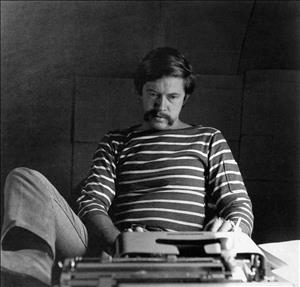This is an excerpt from an article by novelist Tom Robbins on the lightshows of the 1960s. It appeared in Seattle magazine in 1967, and is reprinted with permission of Tom Robbins.
The Lightshow
Metaphorically, a lightshow is where the Illustrious Buddha arm-wrestles with Thomas Edison while Albert Einstein keeps score. Specifically, a lightshow is a sort of orchestration in which projections of light are interwoven with pulsations of sound. One or more rock 'n' roll bands are essential, for it is with -- or against -- the audible rhythms of electrified music that the visual rhythms of electrified light ideally work and play.
From 10 to 20 persons are required to stage a lightshow in a large ballroom ... . Equipment consists primarily of numerous film and slide projectors and a stroboscope or two ... . Slides, film clips, sheets of acetate, ripple wheels, various inks, transparent paints and saucers of gelatin are also utilized in most shows.
Onto walls, floor and ceiling the projectors arbitrarily throw a rapid succession of overlapping abstract and concrete images. A magnified picture of Jesus, quite out of context, lingers just long enough for spectators to recognize Him and lock Him into a train of their private associations. King Kong-sized orange and purple amoebas (created by squeezing colored liquid between two plates of glass held before the beam of an open projector) quake and contort to the beat of the band. Complex radial color patterns slide in and out of focus, breathing with soft baby breaths or thumping like an anxious heart.
Meanwhile, tender bombs of color explode among the dancers, showering them with translucent shrapnel. Quivering moire designs rape retinas indiscriminately. Indoor lightning (produced by shining lights along twisting overhead wires) crackles to the rat-a-tat thunder of the drums. Along with symbols, sounds, colors and iridescences of varying intensities, the dancer-spectators are stuffed into a boundless amorphous sausage of total perceptual experience, where they are reminded a thousand times a second that all of matter -- including man -- is merely slowed-down light.
Is this art? Some people think so. Since the celebrated San Francisco Mime Troupe threw the cosmic switches for the first public light dance show more than two years ago, the medium has grown rapidly in complexity and verve, and more and more serious artists -- and scientists -- are falling under its spell. Internationally known generals of the avant-garde such as Robert Rauschenberg, John Cage, and Robert Morris have had the assistance of top engineers from the Bell Laboratories in producing their light-sound shows in New York. Most of the world's major galleries have lately displayed works composed of neon tubing and/or other lighting devices.
Performing units called "light companies" have sprung up to put on shows. Here in Seattle, Ron McComb, one of the guiding beacons of the Union Light Company, was a full-time art student until it occurred to him "that painting and sculpture is no longer where it's at." The Lux Sit and Dance, another light company that is smaller and more surrealistically oriented than the Union, is directed by Don Paulson, a professional painter who has had numerous shows at Seattle's Woodside Gallery.
It is not difficult, in fact, to see the lightshow as a logical extension of what has been the central direction in painting for more than a century ... . As modern painting and sculpture have sought to define themselves by casting off all superfluous conventions (including subject matter), so artists began to work directly with light sources, transcending the approximations and immitations to which they were limited by paint and polished metal.

